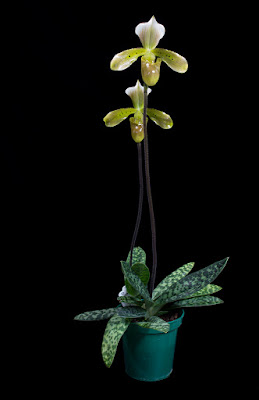Paphiopedilum tonsum is endemic to north and west Sumatra (from Merek to Sidikalang road) between 900 and 1800 meters above sea level. It grows in leafy humus on the forest floor or in humus-filled cracks in limestone rocks and cliffs and sometimes near water seepages.
Paphiopedilum tonsum also called as The Bald Paphiopedilum, Cordula tonsa, Cypripedium tonsum, Paphiopedilum tonsum f. alboviride, is a species of the genus Paphiopedilum. This species was described by Berthold Stein in 1892.
IDENTIFY PAPHIOPEDILUM TONSUM ORCHID PLANT
Paphiopedilum tonsum is endemic to north and west Sumatra (from Merek to Sidikalang road) between 900 and 1800 meters above sea level. It grows in leafy humus on the forest floor or in humus-filled cracks in limestone rocks and cliffs and sometimes near water seepages.
It is a small to medium sized, cool growing herbaceous humus epiphyte with oblong-elliptic, deep green mottled with gray green, up to 20 cm long, 5 cm wide leaves with purple undersides.
The Bald Paphiopedilum blooms in winter and the fall on an erect, terminal, 30 to 37.5 cm long, purple marked, single flowered inflorescence with an elliptic-lanceolate floral bract. The flower has a pinkish white dorsal sepal veined green and dark purple. The outstretched petals are olive to pale yellow-green with darker green veins and may sometimes be flushed dull purple, with a few black warts in the inner surface. The lip is green to olive-brown with pink flushing and has darker brown or maroon veining.
PAPHIOPEDILUM TONSUM ORCHID PLANT CARE AND CULTURE
Cultural information should only be used as a guide, and should be to be adapted to suit you. Your physical location; where you grow your plants, how much time you have to devote to their care, and many other factors, will need to be taken into account. Only then can you decide on the cultural methods that best suit you and your plants.
Light:
Paphiopedilum tonsum like bright sunshine without access to direct sunlight, so during the midday solstice they must be placed behind a curtain or in the shade of other plants.
Temperature:
This orchid need the follow temperature regime: day temperature at 20-25 ° C with night reduction to 16-22 ° C. For successful cultivation at home, the night temperature of the content should always be 3 ° C lower than the daily one.
Humidity:
The humidity of 50-70% will be enough for normal growth and development of the plant. However, at temperatures above 27 ° C, it is desirable to increase the air humidity to at least 70%, since too dry air adversely affects the roots and leaves of the plant. A lot of fresh air and sufficient air circulation are recommended.
Substrate, growing media and repotting:
Paphiopedilum tonsum are grow only in the pot. A mixture of bark of coniferous trees with peat is best suited as a substrate. In addition, it is strongly recommended to add lime to the substrate. Practically not exhausted source of lime are seashells, which can be thoroughly washed from salt, crushed and poured into the substrate.
Repot is necessary annually. The best time for this is spring - the beginning of a new growth. A very important point here is the height of planting. If this orchid is planted incorrectly, for example, too high, the orchid's roots will hang in the air and stop growing. The substrate should cover the upper red-and-white part of the plant for 1-2 fingers, and in no case should it be tamped down, because if the substrate is too dense, the orchid can simply suffocate. When planting, you must take care of a thick layer of drainage to protect the orchid from stagnant water inside the pot.
Watering:
The Bald Paphiopedilum needs frequent and abundant watering throughout the year. Excess water during irrigation should flow freely from the pot, since stagnation of water both inside the pot and in its pan can very quickly lead to rotting of the roots and the lower part of the plant. The substrate between waterings should dry well, but not dry completely. After watering, water from the leaves must be removed with a tissue or tissue.
Spraying the outer part of the plant at home will not lead to anything good, since the structure of its leaves resembles a funnel, and water constantly accumulates in the core of the plant, which can very quickly lead to rotting of both peduncles and the core itself.
Fertilizer:
Throughout the year, this orchid is fertilized once every two weeks in the spring and summer, once every 4 weeks in the fall and winter. Fertilizer should be applied to the plant with 30-10-10 fertilizer, diluted, ¼ teaspoon per week in summer and once a month in winter. Each month to flush the water once to prevent the salt from standing in the pot.
Rest period:
Paphiopedilum tonsum needs a well-defined dormant period to stimulating flowering. It begins, as a rule, in the middle of November, and consists in the fact that orchids are much drier and colder than usual and not fertilized. Night temperature during this period should be no more than 15 ° C. Watering should be replaced with a light, clear spraying of the substrate. After the appearance of peduncles, the dormant period ends: watering is resumed in the usual volume, and the total temperature of the content rises.















COMMENTS